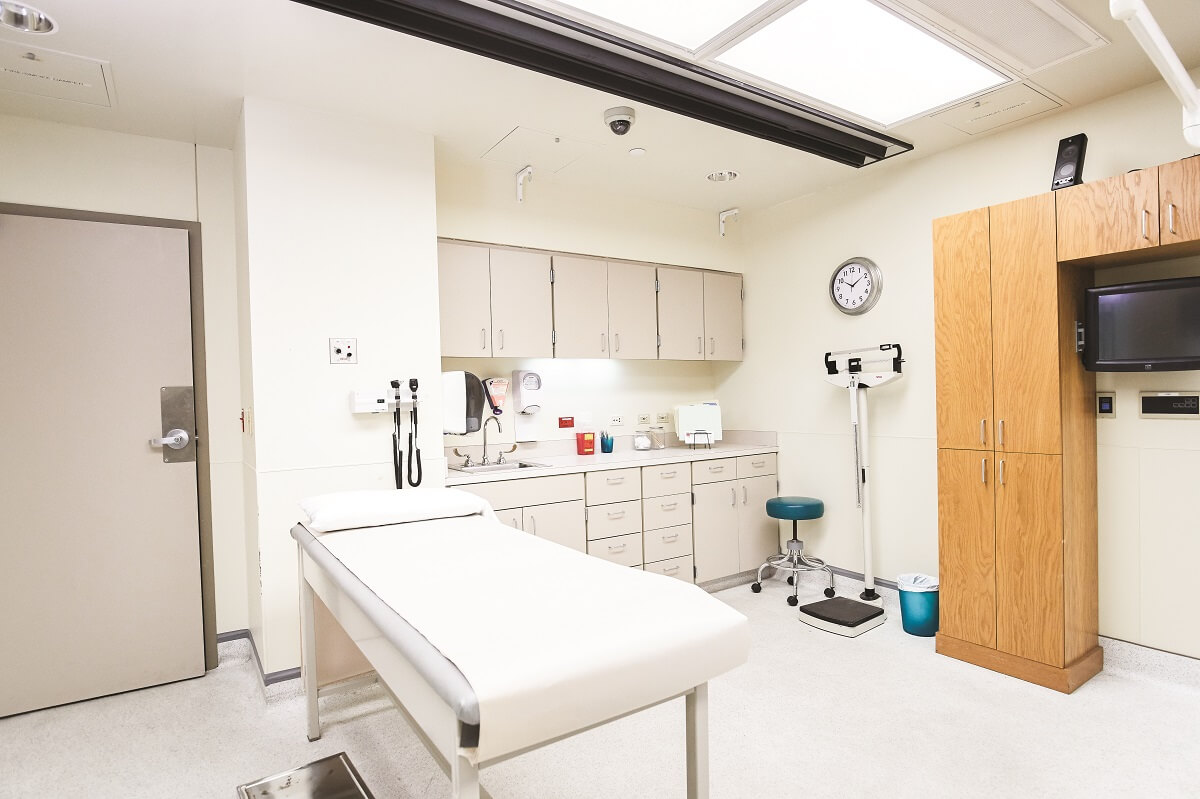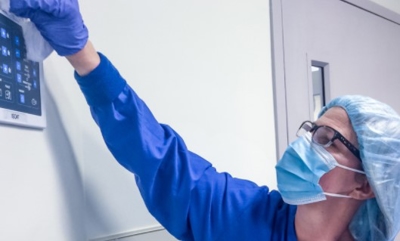How Long Do Pathogens Live on Surfaces?
With the COVID-19 pandemic still looming large across the country, many businesses are facing new questions about their cleaning and disinfecting procedures. In the past, many businesses have scraped by with casual wipe-downs. But it’s clearer than ever that that isn’t good enough. Business owners are now faced with detailed questions like “How long can COVID-19 live on surfaces” or “how long does a disinfectant need to sit in order to do its job.”
Even in hospitals that are accustomed to diligent disinfection, the current pandemic presents new problems, and makes cleanliness more important than ever. COVID-19 is dangerous enough on its own, but its effects on our healthcare system go way beyond the symptoms of the virus. When hospital beds reach capacity and overworked staff strain to take care of full units, all of the hygiene problems hospitals typically face are now amplified. Healthcare-Associated Infections (HAIs) like MRSA (Methicillin-resistant Staphylococcus aureus) and multidrug-resistant organisms (MDROs) like C. auris are an ever-present threat.
From commonly spread germs like flus and colds, to the virus that causes COVID-19, to MDROs that resist attempts at containment, learning how long these pathogens persist in the environment can inform your cleaning and disinfecting decisions. Many of these germs can survive outside of the body for far longer than the average person might imagine. Some can last for months.
How Long Do Cold Germs Live on Surfaces?
For years, folk wisdom has suggested that you catch a cold by being cold. But the truth is that colds are caused by a virus, and no amount of bundling up for the snow can prevent it. The biggest risk of catching a cold comes from standing near an infected person. Colds can cause irritation in your throat and your nasal passageways. That means lots of coughing, sneezing, and runny noses—all of which can spread the cold virus in a hurry. Be mindful of breathing in droplets from someone else’s cough or sneeze. (A mask can help avoid that). You should also be careful about shaking hands with someone who has a cold. The fact is, in cold weather, people tend to huddle together indoors, increasing the spread of germs and likelihood of catching a cold.
While infected surfaces aren’t the biggest risk for transferring colds, they can still be a threat. That threat becomes worse depending on the temperature and humidity of the environment, and the amount of virus that winds up on an infected object. Cold viruses can live on indoor surfaces for up to seven days—though they’re only infectious for about 24 hours. Disinfecting surfaces (especially non-porous surfaces like plastic and stainless steel) can help reduce the risk of spreading an infection.
How Long Does the Flu Virus Live on Surfaces?
The flu viruses (influenza A and influenza B) can survive and remain infectious on hard, nonporous surfaces for up to 24-48 hours. If you send someone home on a Monday morning because they seem sick, and they get flu virus on the doorknob as they’re leaving, that doorknob could be a flu hazard for your customers until Wednesday morning.
On cloth, paper, and tissues, influenza survives for less than 8-12 hours. And on skin, that survival window is even smaller—a matter of minutes, instead of hours. (You should still probably think twice about going for a handshake.)
The good news is that the flu virus is not very hard to kill. Chlorine, hydrogen peroxide, soap, iodine-based antiseptics, and alcohols can all kill the flu virus. So can heat about 167°F/75°C.
How Long Does COVID-19 Last on Surfaces?
SARS-CoV-2 is the name of the coronavirus that causes COVID-19. Research indicates that this virus can stay alive on surfaces for hours or even days, depending on the surface. An early study showed the virus surviving for up to 4 hours on copper, up to 24 hours on cardboard, and up to two or three days on plastic and stainless steel.
But more recently, scientists took a look at how temperature can affect the virus’s ability to survive. It turns out that the colder the temperature is, the longer the coronavirus lasts. For instance, at 68°F/20°C, the virus can last nearly two weeks on cotton. For other surfaces like glass, steel, vinyl, paper, and polymers like the ones used in money around the world, the virus lasted the full 28-day length of the study. So we know that this virus can last on surfaces for nearly a month if it’s not dealt with.
But perhaps most importantly, even that old study, the one that underestimated how long this virus can survive, found that aerosols infected with SARS-CoV-2 can hang around in the air for up to three hours. That means that if someone breathes coronavirus into the air at your place of work, the air could still get people sick for up to three hours after they’re gone. That’s why having and enforcing mask rules is crucial.
COVID-19 is still a relatively new threat, and we’re coming to understand it more all the time. Still, at this point, we’ve been living with it for a year. During that time, it’s been the focus of intense, worldwide study. While some of this information may change over time, the overall message is clear: SARS-CoV-2 is a survivor, and it can spread very easily if appropriate measures aren’t taken.
In addition to wearing masks and enforcing distancing, regular cleaning and disinfection are key to fighting this virus. Wipe down high-touch surfaces often, and consider bringing in professionals to help you combat the spread of this disease with COVID-19 cleaning services. If you do tackle disinfection yourself, make sure that your disinfectants are from the EPA’s list of approved disinfectants for COVID-19, and that you’re taking proper precautions for yourself as you clean.
How Long Doesm C. diff Live on Surfaces?
Clostridioides difficile, or C. diff, is a bacteria that can cause severe diarrhea and colon inflammation. People who are taking antibiotics, or who have taken antibiotics within the last month, are especially at risk of getting a C. diff infection. That’s because antibiotics attack all bacteria inside of the body, including good bacteria that the body needs to help fight off infections. C. diff is listed as an “urgent threat” in the CDC’s most recent report on antibiotic-resistant threats.
Outside of the body, C. diff germs become spores. These spores are inactive and have a protective coating that lets them live for months or even years on surfaces and soil. If these spores reach a person’s intestines, they become active bacteria again, and can cause serious harm. Most healthy people won’t be infected, even if C. diff does reach their intestines. But people with weakened immune systems or those who have recently taken antibiotics can become sick.
C. diff presents a special challenge for healthcare settings. Because of the people that it targets—those on antibiotics and those with compromised immune systems—hospitals can become a hotbed of C. diff infection if precautions aren’t taken. Since C. diff survives for so long, and because it resists the bactericidal effects of many common hospital disinfectants, it requires extra care to protect against. If you have a C. diff case in your medical facility, you’ll need to take extra steps to combat the spores.
How Long Does MRSA Live on Surfaces?
Methicillin-resistant Staphylococcus aureus, or MRSA, is a persistent infectious threat with a long lifespan outside of the body. MRSA typically causes skin infections, but it can also cause pneumonia. Severe cases can even lead to sepsis.
Anyone can get MRSA, and any situation where people are crowded together in close quarters, sharing work equipment, or having skin-to-skin contact poses a risk for MRSA transmission. People who have abrasions or cuts in their skin are especially at risk.
For years, MRSA has primarily been associated with hospitals and healthcare facilities (as well as shared spaces like gyms). While the virus is certainly not limited to medical institutions, it poses a particular threat there. Approximately 5% of all patients in U.S. hospitals carry MRSA in their nose or on their skin (Centers for Disease Control and Prevention, 2019). Whether it develops into an infection or not, these people can still transmit MRSA to other people.
In addition to its resistance to antibiotics, part of what makes MRSA such a significant threat is its ability to survive for long stretches outside of the body—days, weeks, or even months. MRSA can survive for enormous stretches of time, even on fabrics like towels, clothing, or mop heads. Studies on the types of plastics and fabrics used most often in hospitals make it clear that MRSA can thrive on blankets, scrubs, and more without thorough, diligent cleaning.
How Long Does C. auris Live On Surfaces?
Candida auris, or C. auris, is a fungal infection. This “super bug” yeast can enter the bloodstream and spread through the body, causing invasive infections. It’s resistant to many common antifungal drugs, even those used to treat other Candida infections, and it’s difficult to identify without specialized laboratory methods. Conventional lab tests can misidentify it, leading not only to inappropriate treatment of patients, but also insufficient management that won’t stop it from spreading.
C. auris most commonly affects people who already have many medical problems. Those with frequent or extended stays in hospitals or nursing homes are vulnerable. So are people with weakened immune systems from treatments like chemotherapy, people on lots of antibiotics, or people with tubes such as breathing tubes, feeding tubes, or catheters.
More research is needed on how long C. auris can last on surfaces, but current research indicates that it can survive for weeks. We also know that patients who have been treated for active infection can still carry the fungus for several months after recovering. We don’t currently know the maximum amount of time that a patient can be colonized. What we do know is that C. auris can persist both in patients and in the environment for long stretches of time.
Importance of Disinfecting Against Pathogens Other Than COVID-19
Right now, COVID-19 is the highest-profile pathogen by far. While the pandemic is deadly, part of the risk comes not just from COVID-19 itself, but from secondary infections and healthcare-associated infections (HAIs) that can arise as a result of seeking treatment.
Pathogens like Influenza, MRSA, C. auris and more represent a threat to patients and to caregivers alike. Some are quick to spread through a variety of ways. Some are difficult to detect. Some are multidrug resistant organisms that resist common treatments. Each of these unique pathogens must be guarded against with appropriate cleaning and disinfecting procedures.
In an age with so many pathogens threatening care facilities, and with staff already strained by the working conditions caused by COVID-19, it makes more sense than ever to call professional cleaning and disinfection experts like those at ServiceMaster Clean. You can research which antifungal agents and sterilants are effective against C. auris and hope that you deploy them in the right place at the right time. You can check the EPA list of disinfectants approved for use against COVID-19, and try to keep enough of them on hand for your exhausted staff. Or you can allow your internal resources to focus on treating patients and other essential functions while trained cleaning professionals with the right equipment and the right knowledge come in to get the job done.
Disinfection Guidelines to Address These Pathogens
Appropriate cleaning and disinfection protocols are crucial in combating common illnesses, healthcare-associated infections, and drug-resistant pathogens. A few appropriate steps to take include:
- Ensure that all staff follow appropriate hand washing procedures.
- Frequently clean and disinfect high-touch surfaces and shared tools such as computers.
- Have a comprehensive, regular cleaning and disinfecting schedule that includes disinfectants approved by the EPA to combat pathogens like SARS-CoV-2. Make sure that even less commonly touched areas are cleaned and disinfected regularly.
- Issue proper PPE such as gowns, gloves, and masks to staff. Ensure that they are used appropriately and disposed of properly.
- When dealing with certain severe threats like COVID-19 or C. auris, take appropriate contact precautions or enhanced barrier precautions. This can include measures like spatial separation, privacy curtains, isolated rooms, and PPE when dealing with infected patients.
- Ensure that staff are educated around infection control recommendations for unique threats as needed.
- Monitor adherence to infection control practices and implement supervised cleaning of affected areas. Cleaning performed by professionals can help protect from the most dangerous pathogens according to all appropriate guidelines—without placing staff at risk.
A Proper Disinfection Protocol Can Help the Health of Your Business and Patients
With COVID-19 still looming and so many other pathogens lying in wait to attack those with compromised immune systems, cleaning and disinfection are an enormous priority. Whether you’re a hospital trying to ensure the best clinical outcomes or a local business trying to protect your staff, customers, and reputation, bringing in professional disinfection services is an important way to protect yourself and those around you.










